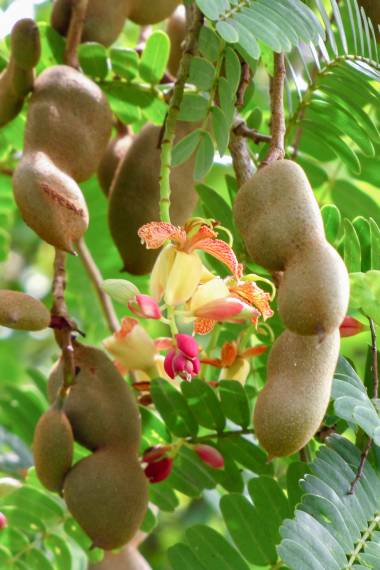New Account | Seed Mix |
Gift Certificates |AAS Winners |
Gardening Products
SEEDS: Unusual | Annuals | Perennials | Vegetables | Herbs | Trees
Tamarind Seeds

JB111 Tamarind ( Tamarindus indica )
The tamarind is a large tropical tree with a short massive
trunk, ferny pinnate leaves, small yellow flowers and fat
reddish brown pods. The tree can get 90 ft (27.4 m) tall but is
usually less than 50 ft (15.2 ft). It has a short, stocky
trunk, drooping branches and a domed umbrella shaped crown
about as wide as the tree's height. The leaves are about 10 in
(25.4 cm) long with 10-18 pairs of 1 in (2.5 cm) oblong
leaflets. Tamarind drops its leaves in pronounced dry seasons;
in climates without a dry season it stays evergreen. The
flowers are about 1 in (2.5 cm) across, pale yellow with purple
or red veins. They have five unequal lobes and borne in small
drooping clusters. The velvety cinnamon brown pods are 2-6 in
(5.1-15.2 cm) long, sausage shaped and constricted between the
seeds. The pulp that surrounds the 8-10 seeds is both sweet and
extremely sour.
Tamarinds are grown as ornamental shade and street trees, and for the edible pods. The pods are fed to livestock, and the pulp within the pods is used to make beverages, curries, chutneys and sauces. Tamarind pulp is made into a soft drink known as refresco de tamarindo in Latin America, and tamarinade in Jamaica. It's also the basis of a popular drink in the Middle East. Tamarind is used extensively in Indian and Southeast Asian cuisine, and is an important ingredient in Worcestershire sauce. The juice is used to pickle fish in India. Several medicinal uses of tamarind are reported in Grieve's A Modern Herbal. The fruit is said to improve digestion, relieve gas, soothe sore throats, and act as a mild laxative.
The tamarind tree is a beautiful, fine textured tree and it makes an excellent shade tree in large landscapes. It often is planted in public parks and as an avenue tree in tropical cities. Best for zones 10 and up.
Tamarinds are grown as ornamental shade and street trees, and for the edible pods. The pods are fed to livestock, and the pulp within the pods is used to make beverages, curries, chutneys and sauces. Tamarind pulp is made into a soft drink known as refresco de tamarindo in Latin America, and tamarinade in Jamaica. It's also the basis of a popular drink in the Middle East. Tamarind is used extensively in Indian and Southeast Asian cuisine, and is an important ingredient in Worcestershire sauce. The juice is used to pickle fish in India. Several medicinal uses of tamarind are reported in Grieve's A Modern Herbal. The fruit is said to improve digestion, relieve gas, soothe sore throats, and act as a mild laxative.
The tamarind tree is a beautiful, fine textured tree and it makes an excellent shade tree in large landscapes. It often is planted in public parks and as an avenue tree in tropical cities. Best for zones 10 and up.
For over a thousand more unique seed varieties, all in stock and ready to ship, visit our Seed Catalog Index Page .

